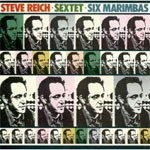2pft[=2elec.pft(synth)].-perc(4):pft/2vib(bowed)/3marimba/tam-t/click sticks/2BD/crot (+ amplification)
This work requires additional technological components and/or amplification.
Abbreviations (PDF)
Boosey & Hawkes (Hendon Music)
Sextet was commissioned by Laura Dean Dancers and Musicians and by the French Government for the Nexus Percussion Ensemble. The first performance under the title Music for percussion and Keyboards was given at the Centre Pompidou in Paris on 19 December 1984 by Nexus with guest artists playing keyboards. The last movement was then revised in January 1985 and the title shortened to Sextet. The American premiere was presented by Laura Dean Dancers and Musicians at Brooklyn Academy of Music’s New Wave Festival on 31 October 1985 as the music for Ms. Dean’s Impact. The American concert premiere by Steve Reich and Musicians was performed on the Great performers Series at Avery Fisher Hall on 20 January 1986. Sextet (1985) for 4 percussionists and 2 keyboard players is score for 3 marimbas, 2 vibraphones, 2 bass drums, crotales, sticks, tam-tam, 2 pianos and 2 synthesizers. The duration is about 28 minutes.
The work is in five movements played without pause. The relationship of the five movements is that of an arch form A-B-C-B-A. The first and last movements are fast, the second and fourth moderate and the third, slow. Changes of tempo are made abruptly at the beginning of new movements by metric modulation to either get slower or faster. Movements are also organised harmonically wit the chord cycle for the first and fifth, another for the second and fourth, and yet another for the third. The harmonies used are largely dominant chords with added tones creating a somewhat darker, chromatic and more varied harmonic language were suggested by The Desert Music (1984).
Percussion instruments mostly produce sounds of relatively short duration. In this piece I was interested in overcoming hat limitation. The use of the bowed vibraphone, not merely as a passing effect, but as a basic instrumental voice in the second movement, was one means of getting long continuous sounds not possible with piano. The mallet instruments (marimba, vibraphone etc) are basically instruments of high and middle register without a low range. To overcome this limit the bass drum was used doubling the piano or synthesizer played in their lower register, particularly in the second, third and fourth movements.
Compositional techniques used include some introduced in my music as early as Drumming in 1971. In particular the substitution of beats for rests to "build-up" a canon between two or more identical instruments playing the same repeating pattern is used extensively in the first and last movements. Sudden change of rhythmic position (or phase) of one voice in an overall repeating contrapuntal web first occurs in my Six Pianos of 1973 and occurs throughout this work. Double canons, where one canon moves slowly (the bowed vibraphones) and the second moves quickly (the pianos), first appear in my music in Octet of 1979. Techniques influenced by African music, where the basic ambiguity in meters of 12 beats is between 3 groups of 4 and 4 groups of 3, appear in the third and fifth movements. A rhythmically ambiguous pattern is played by vibraphones in the third movement, but at a much faster tempo. The result is to change the perception of what is in fact not changing. Another related, more recent techniques appearing near the end of the fourth movement is to gradually remove the melodic material in the sythesizers leaving the accompaniment of the 2 vibraphones to become the new melodic focus. Similarly the accompaniment in the piano in the second movement becomes the melody for the synthesizer in the fourth movement. The ambiguity here is between which is melody and which is accompaniment. In music which uses a great deal of repetition I believe it is precisely these kinds of ambiguities that give vitality and life
— Steve Reich
Reproduction Rights:
This program note may be reproduced free of charge in concert programs with a credit to the composer.
The electronic elements of this work may be licensed from RealTime Solutions or ordered directly from Boosey & Hawkes. Contact the Boosey & Hawkes Rental Library for more information.

Nexus
Nonesuch 7559791382

